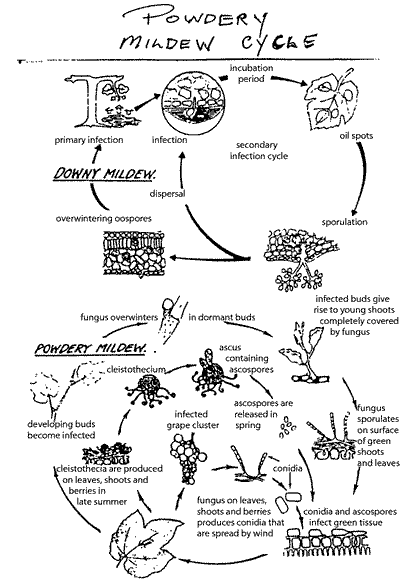
GRAPE DISEASES
SCIENTIFIC NAME: Vitis vinifera
FAMILY: Vitaceae
Following the disastrous season last year for Downy Mildew, we invited Trevor Wicks, from the Department of Primary Industry, to inform us more on this and other grape diseases.
Downy and Powdery Mildew are often confused with each other.
DOWNY MILDEW
This was a major problem in all areas of Australia last year; it normally occurs seriously in South Australia 1 in 10 years. Yellow oily spots appear on the upper surface of leaves then, if there is a warm, wet night, e.g. 97-100% humidity, on the bottom side spores grow which look like down (hence the name). If it is suspected, the best test is to put a leaf in a sealed plastic bag in a dark area - if Downy Mildew is present, spores will grow. Pea-sized berries will survive, although fruit stalks can be affected and hence cause crop loss. Last year it also grew on tendrils and killed young shoots. Berries will be a dark olive green if they are affected. Phosphoric acid is the best to eradicate the disease after the symptoms show. There are no commercial biological means to control the disease. The copper-based fungicides Bordeaux or Copper Oxychloride sprayed on a regular basis to coat the under-surface of all new leaves are the most effective backyard protection. The key is to identify the disease correctly, as the control measures for powdery mildew are different.

POWDERY MILDEW
This occurs every year in mild overcast conditions with high humidity. It does not like Ultra Violet light so grows in a shaded canopy. Powdery Mildew is like a very fine dust (hence the name 'powdery'). Young green tissue is affected on both sides of the leaf. It will survive from one season to the next in buds. Wettable Sulphur spray (on days less than 30°C) is the best to control Powdery Mildew. The critical stage for treatment is around flowering (Oct/Nov), before, during and after. Summer pruning to keep an open canopy, and leaf removal near flowers and bunches helps.
BOTRYTIS (Grey Mould)
Botrytis is a fungal disease which affects the berries. It attacks the grapes at flowering and remains dormant until berries ripen. Fungicides are used to control the disease, the most effective being Benlate. If used too often, resistance can develop, therefore, alternate with Rovral. It is difficult to control once the berries are affected. If your grapes have the disease, ensure all affected bunch stems are cut off in winter so none carry over to next season. Leaf removal as for Powdery Mildew will help also.
BLACK SPOT
Black Spot is a fungal disease which appears as spots on fruit. It carries over from season to season, being worse on sultanas. Bud swell is the best time to spray. The most effective fungicide is Ziram.
(Tech.Ed's note: 'Mancozeb Plus' contains Mancozeb for Downy and Sulphur for Powdery Mildews).
DATE: March 1994
* * * * * * * * * * * * *
